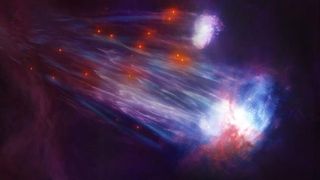News
Science & Astronomy

(Image credit: CfA / Melissa Weiss)
A river of hydrogen gas flows outward from the Large and Small Magellanic Clouds, two dwarf galaxies located in the outskirts of the Milky Way. The contents of this river, called the Magellanic Stream, has puzzled astronomers for decades. But now, for the first time, a team of researchers has been able to locate stars within the stream’s gaseous clouds. The discovery will not only help them better understand the evolution of the stream’s home galaxies, but also the distribution of matter in the Milky Way itself.
The astronomers, from the Harvard–Smithsonian Center for Astrophysics, found the stars using the 21-foot (6.5 meters) Magellan Baade Telescope at Las Campanas Observatory in Chile. With the help of a detailed Milky Way map, created by the European Space Agency’s Gaia space telescope, the researchers zeroed-in on 200 stars sitting in the farthest reaches of our galaxy, located in the direction of the Magellanic Stream.
They analyzed the spectrum of light emanating from those stars and found that the chemical composition of 13 subjects matched that of the Magellanic Clouds. The measurements also suggested that those 13 stars must be between 150,000 and 400,000 light-years from Earth, about the expected distance of the Magellanic Stream.
Related: The Magellanic Clouds must be renamed, astronomers say
The stream, originally discovered in the 1970s, spreads over a region of the Southern Sky equivalent to the size of 300 full moons as seen from Earth. But despite its enormity, it takes some sensitive equipment to see it.
Astronomers think the gas that makes up the stream was torn from the dwarf galaxies by the gravitational pull of the Milky Way. The new observations may reveal more about the stream’s nature and assist scientists who seek to understand how it interacts with our galaxy. As of now, scientists say, the stream appears to be sort of falling into the Milky Way.
“With these results and more like them, we hope to gain a far greater understanding of the formation of the Magellanic Stream and the Magellanic Clouds, as well as their past and future interactions with our galaxy,” Charlie Conroy, a Professor of Astronomy at the Harvard-Smithsonian Center for Astrophysics (CfA), and co-author of the research, said in a statement.
Unlike the Magellanic Stream, the Magellanic Clouds have been known to humankind since antiquity as they are clearly visible with the naked eye. Still, however, astronomers have many questions about the origin and history of these two galaxies, which seem to be colliding with the Milky Way. Mapping and modeling the Magellanic Stream will help astronomers advance the understanding of its source galaxies, whose past trajectory it is believed to trace.
“The beauty of having a vast stellar stream like the Magellanic Stream is that we can now perform so many astrophysical investigations with it,” Vedant Chandra, a PhD student in astronomy and astrophysics at the CfA and lead author of the study, said in the statement. “As our spectroscopic survey continues and we find more stars, we’re excited to see what other surprises the galactic outskirts have in store for us.”
Scientists think that, as hydrogen gas from the stream falls into the Milky Way, it creates the right conditions for star formation. By analyzing the data, the researchers also found that the stream is about twice as massive than they thought, which means that much more gas must be getting devoured by the Milky Way than previous calculations had suggested.
“The Magellanic Stream is the dominant source of stellar calories for the Milky Way — it’s our breakfast, lunch and dinner,” Ana Bonaca, co-author on the study and former postdoctoral fellow at the CfA, now staff scientist at Carnegie Observatories, said in the statement. “Based on the new, higher mass estimates for Magellanic Stream, the Milky Way may end up packing on more pounds than initially thought.”
By better constraining the mass of the stream and by gaining a better understanding of the Magellanic Clouds, astronomers will be able to better estimate the mass distribution of the entire Milky Way, the scientists said in the statement.
“Much of that mass is in the form of dark matter—a poorly understood, gravity-exerting substance,” the scientists said. “Better gauging the mass of our galaxy out in its distant hinterlands will aid in accounting for ordinary matter versus dark matter contents, constraining the possible properties of the latter.”
The study was published in October in the Astrophysical Journal.
Join our Space Forums to keep talking space on the latest missions, night sky and more! And if you have a news tip, correction or comment, let us know at: [email protected].
Breaking space news, the latest updates on rocket launches, skywatching events and more!
Tereza is a London-based science and technology journalist, aspiring fiction writer and amateur gymnast. Originally from Prague, the Czech Republic, she spent the first seven years of her career working as a reporter, script-writer and presenter for various TV programmes of the Czech Public Service Television. She later took a career break to pursue further education and added a Master’s in Science from the International Space University, France, to her Bachelor’s in Journalism and Master’s in Cultural Anthropology from Prague’s Charles University. She worked as a reporter at the Engineering and Technology magazine, freelanced for a range of publications including Live Science, Space.com, Professional Engineering, Via Satellite and Space News and served as a maternity cover science editor at the European Space Agency.
>>> Read full article>>>
Copyright for syndicated content belongs to the linked Source : Space.com – https://www.space.com/stars-discovered-in-magellanic-stream-first-time






























